Palmer Station Timeline
2015-present
Winter 2015
Manager: Bob DeValentino; population 21 (list and photos)
Google Trekker backpacking camera put to use around the station.
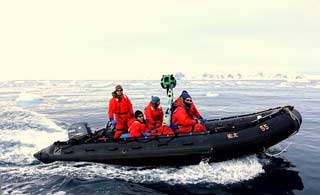 Google makes these Street View cameras available to nonprofits and research groups. Here it is being transported by the Texas A&M long-term environmental monitoring project, led by investigator Andrew Klein, to capture 360º imagery from sites of interest around the station. These have included the glacier, Biscoe Point, and Bonaparte Point. This photo, by Ryan Andres, appeared in the May 2015 station science report.
Google makes these Street View cameras available to nonprofits and research groups. Here it is being transported by the Texas A&M long-term environmental monitoring project, led by investigator Andrew Klein, to capture 360º imagery from sites of interest around the station. These have included the glacier, Biscoe Point, and Bonaparte Point. This photo, by Ryan Andres, appeared in the May 2015 station science report.The project team blog archive is here, although it mostly covers previous visits to the station and the photos are gone. The project also posted on their Facebook page through 2019.
The Laurence M. Gould encounters heavy sea ice after a final fishing trip (12 June)...
 ...resulting a photo op for Cynthia Spence to take this amazing panorama
(link to USAP photo library original). The fishing trip was for frequent Palmer icefish researcher Kristin O'Brien's team--their visit was blogged extensively by team member Stuart Egginton--a resource that has unfortunately disappeared. However, this Ohio University article about the 3 OU researchers on the project team is still around. It describes the mission of the aluminum landing craft (called the "tin can" in the article) to bring fish samples back to Palmer when the Gould was blocked by the ice conditions. That mission is depicted in another of Cynthia's photos in the USAP photo library. The ice eventually cleared out on 23 June, allowing the LMG to dock, allow members of the AIMS team (developers of the Palmer Station master plan (see below) to visit briefly, and take the rest of the summer folks north on the 26th.
...resulting a photo op for Cynthia Spence to take this amazing panorama
(link to USAP photo library original). The fishing trip was for frequent Palmer icefish researcher Kristin O'Brien's team--their visit was blogged extensively by team member Stuart Egginton--a resource that has unfortunately disappeared. However, this Ohio University article about the 3 OU researchers on the project team is still around. It describes the mission of the aluminum landing craft (called the "tin can" in the article) to bring fish samples back to Palmer when the Gould was blocked by the ice conditions. That mission is depicted in another of Cynthia's photos in the USAP photo library. The ice eventually cleared out on 23 June, allowing the LMG to dock, allow members of the AIMS team (developers of the Palmer Station master plan (see below) to visit briefly, and take the rest of the summer folks north on the 26th.
Summer 2015-16
Building LIDAR and thermal image survey conducted (October).
 The survey, conducted by CRREL representatives Elias Deeb and Adam LeWinter, was not unlike a similar project I was involved in at Pole in November 2005, to characterize deficiencies in the building exterior and prioritize energy improvement activities. These two images (of the back side of GWR, from the October 2015 science report) depict a raw LIDAR image (left) and a thermal image (right depicting temperature values of the siding surface. Seen here...apparent insulation damage under the windows due to water leakage, as well as heat loss to the right of the 4 windows where perhaps another window was removed or never installed.
The survey, conducted by CRREL representatives Elias Deeb and Adam LeWinter, was not unlike a similar project I was involved in at Pole in November 2005, to characterize deficiencies in the building exterior and prioritize energy improvement activities. These two images (of the back side of GWR, from the October 2015 science report) depict a raw LIDAR image (left) and a thermal image (right depicting temperature values of the siding surface. Seen here...apparent insulation damage under the windows due to water leakage, as well as heat loss to the right of the 4 windows where perhaps another window was removed or never installed.
Rutgers air sampling experiment set up in the backyard (November).
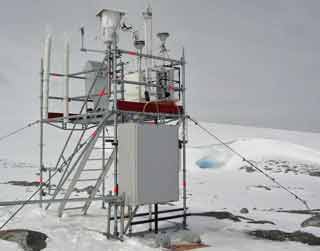
This was a Rutgers project led by investigator Yuan Gao, to measure and quantify atmospheric iron, using a number of different air samplers and an associated weather station, which of course required this platform, along with power and data connections. They also collected area snow samples. The team returned to install additional equipment in November 2016, and the project was completed and dismantled at the end of January. This photo, by Yuan Gao, is from the November 2015 science sitrep.
Newly revealed island named for long time Palmer researcher Bill Detrich.
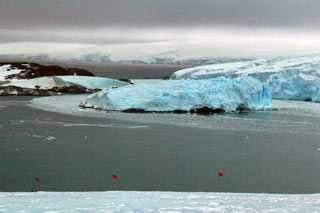
Melting ice cover around Arthur Harbor recently revealed yet another new island 3/4 mile north of the station. It actually started to appear in 2012. On 19 January 2016 the U.S. Board on Geographic Names accepted the name Detrich Island for this 100' high ice-covered island. A 2 March 2016 Northeastern University news article describes the island and zooms in on its satellite photo...and a custom Google map allows us to zoom in on the island, the station, and the fast-melting glaciers that could eventually reveal that the station itself is on an island (note, you may need to zoom out to see the image). The photo (from the article) is by University of Oregon researcher Thomas Desvignes.
New Palmer Station master plan unveiled (2 February).
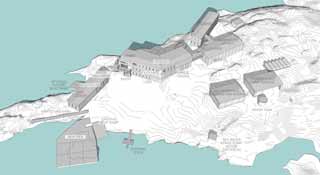
The plan is another phase in the eventual rework of the station following upon the 2012 Blue Ribbon Panel report. It was prepared by a team led by OZ Architecture which also produced the McMurdo master plan. Major features--replacing the biolab and boathouse buildings, reworking GWR, and constructing new berthing ("lodging") and power plant buildings. Phase 1 is, of course, a new pier. The plan is available here.
Winter 2016
Manager: Ken Keenan; population 21 (list and photos)
The first of the RHIB's undergoes sea trials (July).
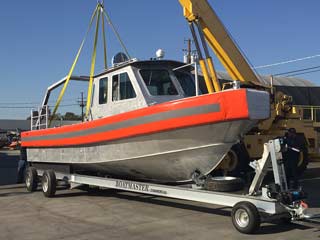
At left, the first of the two new 33-1/2 foot aluminum vessels is being test fitted to its trailer. More details about the vessel specifications, construction photos, and the sea trial video off of Long Beach, can be found here.
Leidos takes over the Antarctic Support Contract from Leidos (16 August).

This was perhaps due in part to a "Reverse Morris Trust" arrangement--a way for L-M to recover cash (potentially $8 billion) to pay for their acquisition of Sikorsky, and to offset their loss of the long range bomber program to Grumman. Needless to say, the USAP contract was NOT the key piece of L-M's business that Leidos wanted, My full coverage is here, with detailed links. At left, my August 2017 photo of the current sign in front of the ASC project headquarters building.
Summer 2016-17
CBS News team, led by correspondent Mark Phillips, visits Palmer Station (14 February).
 As part of the CBS News "Climate Diaries" series, they visited in mid February aboard the cruise ship National Geographic Explorer. Coverage included interviews with longtime manager Bob Farrell and penguin researcher Shawn Farry, who described the 85% decline in Adelie penguin populations (from 9000 to 1200) since 1973 (Keri Nelson's photo of Shawn's interview), aerial photos documenting the receipt of the glaciers in Arthur Harbor (at left of Mark Phillips standing on Dietrich Island, which appeared on 14 March 2014), and discussion on whether the station itself is actually on a small island.
Watch the video here.
As part of the CBS News "Climate Diaries" series, they visited in mid February aboard the cruise ship National Geographic Explorer. Coverage included interviews with longtime manager Bob Farrell and penguin researcher Shawn Farry, who described the 85% decline in Adelie penguin populations (from 9000 to 1200) since 1973 (Keri Nelson's photo of Shawn's interview), aerial photos documenting the receipt of the glaciers in Arthur Harbor (at left of Mark Phillips standing on Dietrich Island, which appeared on 14 March 2014), and discussion on whether the station itself is actually on a small island.
Watch the video here.
The first of the two new RHIB's gets its first launching at Palmer Station (3 March).
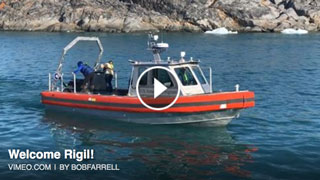 The vessel procurement, construction, and testing has been discussed before here. The first of these, Rigil. recently was delivered. The second one, named Hadar, will show up later. They're named for Southern Hemisphere stars used by sailors for navigation. Here's the video posted by Bob Farrell, and here's Chuck Amsler's photo of Bob Farrell at the helm on the maiden voyage. UPDATES: Rigel's first science mission on 12 May allowed members of the Amsler/ Baker/McClintock team to take a dive (Maggie Amsler's photo from the May 2017 science sitrep). Also see Ken Keenan's video of a deployment which also included divers in the water.
The vessel procurement, construction, and testing has been discussed before here. The first of these, Rigil. recently was delivered. The second one, named Hadar, will show up later. They're named for Southern Hemisphere stars used by sailors for navigation. Here's the video posted by Bob Farrell, and here's Chuck Amsler's photo of Bob Farrell at the helm on the maiden voyage. UPDATES: Rigel's first science mission on 12 May allowed members of the Amsler/ Baker/McClintock team to take a dive (Maggie Amsler's photo from the May 2017 science sitrep). Also see Ken Keenan's video of a deployment which also included divers in the water.
The R/V Hero sinks at its moorings (4 March).
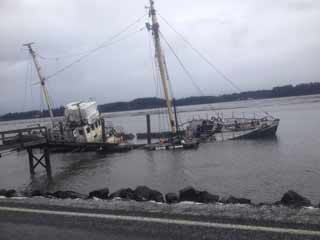
This tragedy is still evolving, and the details of why it sank when it did may never be known...although this is not totally unexpected. The Coast Guard, the Washington Department of Ecology, and the Pacific County sheriff's office and Emergency Management Agency were involved, and a contractor removed diesel and lube oil. And I was a bit involved in providing them information. For now the vessel is just sitting there...perhaps eventually Washington State may remove it. The story so far....
James McClintock, a member of the UAB team, is interviewed by NPR host David Green (8 March).
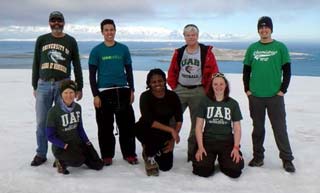 The subject of the interview...changes he's seen over the years due to the warming temperatures. The team (left, seen up on the glacier) arrived in February, from left we have (standing) Chuck Amsler, Leucas Miller, Jim McClintock, and Andrew Shilling; and kneeling: Maggie Amsler, Santana Thomas, and Sabrina Heiser (Santana and Andrew are from USF). They are diving to collect and study red and brown algae, as well as the amphipod Paradexamine fissicauda that loves to eat the algae. Here's one of Maggie's 2013 blog posts which featured a video of that amphipod eating the algae (that video is now available here). This photo is from Maggie Amsler.
The subject of the interview...changes he's seen over the years due to the warming temperatures. The team (left, seen up on the glacier) arrived in February, from left we have (standing) Chuck Amsler, Leucas Miller, Jim McClintock, and Andrew Shilling; and kneeling: Maggie Amsler, Santana Thomas, and Sabrina Heiser (Santana and Andrew are from USF). They are diving to collect and study red and brown algae, as well as the amphipod Paradexamine fissicauda that loves to eat the algae. Here's one of Maggie's 2013 blog posts which featured a video of that amphipod eating the algae (that video is now available here). This photo is from Maggie Amsler.
Winter 2017
Manager: Ken Keenan; population 20 (list and photos)
Plan to replace the 50-year-old pier advances.
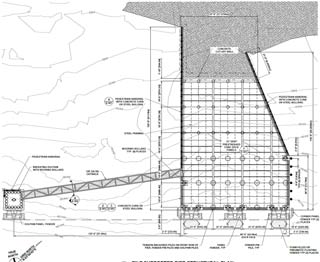 It has been falling apart...as can be seen in this 2009 RPSC survey report. In May 2017, the Future USAP team completed a 35% design for a new pier (left) consisting of a precast concrete deck supported by pipe piles. The design includes new fenders, fuel/electrical connections, and armor rock wave protection for the adjacent small boat dock. It would increase pier size from 1800 square feet with 18-foot water depth, to 8000 square feet with 34-foot water depth. It now awaits funding. Hindsight: it is much better than the 1986 proposal for a jackup type addition to the existing pier. The Alaska firm R&M Consultants was the principal designer--here's an information sheet from subcontractor Great Northern Engineering about their project work. The 2009 survey report mentioned above is from this 2013 project solicitation. When? My early 2020 info: perhaps in 2021-22. Meanwhile, the anodes were to be replaced in 2017-18.
It has been falling apart...as can be seen in this 2009 RPSC survey report. In May 2017, the Future USAP team completed a 35% design for a new pier (left) consisting of a precast concrete deck supported by pipe piles. The design includes new fenders, fuel/electrical connections, and armor rock wave protection for the adjacent small boat dock. It would increase pier size from 1800 square feet with 18-foot water depth, to 8000 square feet with 34-foot water depth. It now awaits funding. Hindsight: it is much better than the 1986 proposal for a jackup type addition to the existing pier. The Alaska firm R&M Consultants was the principal designer--here's an information sheet from subcontractor Great Northern Engineering about their project work. The 2009 survey report mentioned above is from this 2013 project solicitation. When? My early 2020 info: perhaps in 2021-22. Meanwhile, the anodes were to be replaced in 2017-18.Summer 2017-18
The second of two RHIB's is delivered (October). It was named Hadar after the second brightest...
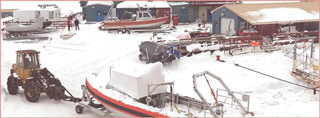 ...star in the constellation Centaurus--one of the two pointer stars to the Southern Cross. This is in keeping with the naming of the first RHIB Rigel which is named for the brightest star in the constellation Orion. Both of these boats would get a significant workout by the summer science groups. The two largest Zodiacs are being retired, as the new boats are much better replacements. This NSF photo is from the Polar Programs Facebook page.
...star in the constellation Centaurus--one of the two pointer stars to the Southern Cross. This is in keeping with the naming of the first RHIB Rigel which is named for the brightest star in the constellation Orion. Both of these boats would get a significant workout by the summer science groups. The two largest Zodiacs are being retired, as the new boats are much better replacements. This NSF photo is from the Polar Programs Facebook page.
William Fraser's team returned for another summer of penguin study.
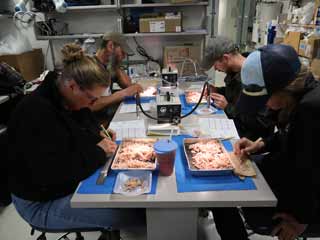 Bill Fraser has been studying penguins at Palmer Station ever since his 1975 winter, and I met him more than once in the late 80s...as well as his then-future wife Donna Fraser (at left). To her right are Shawn Farry, Ben Cook, and Carrie McAtee -- they are studying regurgitated penguin diet (2 February USAP photo library photo by Keri Nelson). In other work this the season they counted eggs (and later measured the chicks), monitored brown skua chicks, censused giant petrel nests, and kept an eye on south polar skuas, blue-eyed shags, kelp gulls, and other birds. Here's an impressive rare photo from the Fraser group (from the December 2017 science sitrep) of all three species of penguins in the study area--Adelie, gentoo, and chinstrap!
Bill Fraser has been studying penguins at Palmer Station ever since his 1975 winter, and I met him more than once in the late 80s...as well as his then-future wife Donna Fraser (at left). To her right are Shawn Farry, Ben Cook, and Carrie McAtee -- they are studying regurgitated penguin diet (2 February USAP photo library photo by Keri Nelson). In other work this the season they counted eggs (and later measured the chicks), monitored brown skua chicks, censused giant petrel nests, and kept an eye on south polar skuas, blue-eyed shags, kelp gulls, and other birds. Here's an impressive rare photo from the Fraser group (from the December 2017 science sitrep) of all three species of penguins in the study area--Adelie, gentoo, and chinstrap!
UK Antarctic Heritage Trust and NZ AHT conduct major conservation effort on Stonington Island.
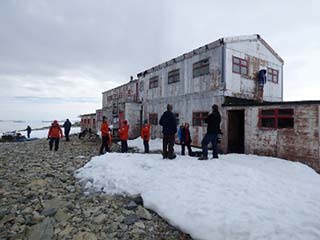 They spent ten weeks mainly conserving the two-story 1961 BAS Base E building, which replaced an original 1948 base. It was occupied from 1946-50, briefly during IGY, and again from 1960-75. It is 800 feet from the 1939-41 USAS East Base, also occupied by Finn Ronne's expedition in 1947-48. The team worked on both base sites. This photo is from one of the UKAHT photo diaries of the work [which were not archived and are no longer available]--here the team escorts tourists from the National Geographic Explorer. This general page about the project is still available, as is this archived UKAHT page about the project. The team included Michael Powell, the 2001 Rothera base commander and husband of Liesl Schernthanner. I visited Stonington in March 1990 on an NSF visit to plan future conservation. I most recently met Michael, Liesl, and Bob Dodson (who wintered there in 1948) in July 2018 at the Antarctican Society gathering in Maine. Here's a great UKAHT video about the project which is still available.
They spent ten weeks mainly conserving the two-story 1961 BAS Base E building, which replaced an original 1948 base. It was occupied from 1946-50, briefly during IGY, and again from 1960-75. It is 800 feet from the 1939-41 USAS East Base, also occupied by Finn Ronne's expedition in 1947-48. The team worked on both base sites. This photo is from one of the UKAHT photo diaries of the work [which were not archived and are no longer available]--here the team escorts tourists from the National Geographic Explorer. This general page about the project is still available, as is this archived UKAHT page about the project. The team included Michael Powell, the 2001 Rothera base commander and husband of Liesl Schernthanner. I visited Stonington in March 1990 on an NSF visit to plan future conservation. I most recently met Michael, Liesl, and Bob Dodson (who wintered there in 1948) in July 2018 at the Antarctican Society gathering in Maine. Here's a great UKAHT video about the project which is still available.
New massive penguin colony found! One might wonder why we are still studying penguins, but here's proof. This colony was discovered not by the Fraser group or other USAP scientists working at sea level around the peninsula, but by a multinational research team who examined Landsat and older satellite images and found pinkish-red guano stains on the Danger Islands (a group of 9 islands just north of the Antarctic Peninsula and about 15 miles SSE of Joinville Island (see below). The team, including Oxford University researcher and friend Tom Hart, visited the hard-to-reach islands in 2015; their drone survey revealed about 750,000 breeding pairs of Adelie penguins. Media coverage with videos include this 2 March 2018 BBC News article, this 2 March Guardian article, and this 5 March New York Times article. The 2 March paper "Multi-modal survey of Adélie penguin mega-colonies reveals the Danger Islands as a seabird hotspot" is here--open access, published in Scientific Reports.
USAP scientists on Joinville Island rescued by Argentine naval helicopter (11 March).

The team, led by principal investigator Alexander Simms, had been investigating newly discovered raised beaches on Joinville Island, but as time approached for their pickup by the Laurence M. Gould, the Weddell Sea ice conditions deteriorated and the LMG was unable to approach the island. USAP requested assistance from Argentina, as their naval icebreaker Almirante Irizar was in the vicinity, and a helicopter from the icebreaker picked up the science team and their gear. More information, photos, and video....
The 50th anniversary of the permanent station is commemorated (20 March)

The Biolab was dedicated on 20 March 1968...50 years on from that was a significant dedication ceremony, with speeches, a toast, and significant historical photographs from the 1968 event from someone who was there. Check it out!
FIVE 2017 Polies head to Palmer station for the winter at the same time!
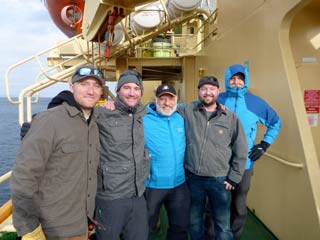 This may or may not be a first, but in late March, these five 2017 winterover Polies were headed across the Drake Passage for the 2018 winter at Palmer Station. Seen here aboard the Laurence M. Gould are (from left) Steven Ashton, cargo; Josh Neff, maintenance specialist; Rick Osburn, carpenter; Eric Hansen, PM coordinator; Mike Rice, communications engineer. There trip south was not entirely uneventful--the vessel was diverted to Ushuaia after one of the people aboard required serious medical treatment (they were later evacuated to the US and were doing well). The ship reached Palmer Station at the end of March. And note that the crew of approximately 20 winterovers will include a few other Polies who've wintered in previous years. This photo is courtesy Mike Rice, thanks!
This may or may not be a first, but in late March, these five 2017 winterover Polies were headed across the Drake Passage for the 2018 winter at Palmer Station. Seen here aboard the Laurence M. Gould are (from left) Steven Ashton, cargo; Josh Neff, maintenance specialist; Rick Osburn, carpenter; Eric Hansen, PM coordinator; Mike Rice, communications engineer. There trip south was not entirely uneventful--the vessel was diverted to Ushuaia after one of the people aboard required serious medical treatment (they were later evacuated to the US and were doing well). The ship reached Palmer Station at the end of March. And note that the crew of approximately 20 winterovers will include a few other Polies who've wintered in previous years. This photo is courtesy Mike Rice, thanks!
Winter 2018
Manager: Ken Keenan; population 20 (list and photos)
Antenna riggers show up in April to do stuff...

They had lots of work on and around the various antenna towers, but one of their tasks was to replace damaged panels on the earth station 8-meter radome. At left...one of the damaged panels was unbolted so it could be pushed out and lowered to the ground by rope. Here's a view from outside. The satcom earth station was constructed during the 2002 winter...the 5-meter dish does not normally have to move as it points to the geosynchronous Intelsat-23 satellite. The terminal at the other end is near Malibu, CA.
Thanks to Mike Rice for the photos and information!
Artist Karen Romano Young spends 3 months on station (March-May).
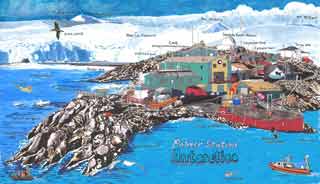
Karen is prolific children's author and illustrator currently living in Connecticut. She created a science comic story "Antarctic Log" which she started in July 2017 before her trip to Palmer Station. The photo at left is a great cartoon map of the station that she created. Here's a complete gallery which unfortunately does not include the photo at left.
Summer 2018-19
Death at Palmer Station (23 October)

Paul Eugene Kyllonen, age 57, died due to natural causes at about 1130 local time (UTC-3) on Tuesday 23 October. He had arrived on station with the first group of the summer crew on 6 October. He had previously wintered at Palmer in 1998 as an equipment operator/mechanic and in 2002 and 2003 as the power plant mechanic. (more photos, information, and credits).
Palmer pier project progresses.
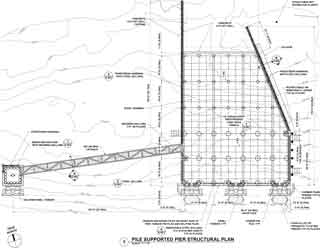 On 17 December 2018, NSF announced that they were issuing a preliminary "sources sought" solicitation for the replacement pier. This is based on the 35% design drawings completed in mid-2017 (and discussed above) after their review. The lead design firm is R&M Consultants (Anchorage). This was not a request for proposals, but a "testing of the market" to determine potential contracting strategies, similar to what was done for the satellite earth station now under construction at McMurdo by ASC employees. Responses were due by 7 February 2019. The USAP announcement is here; the official solicitation (with a link to the preliminary drawing package) is here, and the drawing package itself (source of the image at left) is here (43 MB). The solicitation states that construction would occur in 2021-22, which, as of January 2022, is happening.
On 17 December 2018, NSF announced that they were issuing a preliminary "sources sought" solicitation for the replacement pier. This is based on the 35% design drawings completed in mid-2017 (and discussed above) after their review. The lead design firm is R&M Consultants (Anchorage). This was not a request for proposals, but a "testing of the market" to determine potential contracting strategies, similar to what was done for the satellite earth station now under construction at McMurdo by ASC employees. Responses were due by 7 February 2019. The USAP announcement is here; the official solicitation (with a link to the preliminary drawing package) is here, and the drawing package itself (source of the image at left) is here (43 MB). The solicitation states that construction would occur in 2021-22, which, as of January 2022, is happening.Winter 2019
Manager: Ken Keenan; population 20 (list and photos)
Palmer Station veteran Maggie Amsler completes her 500th dive in Antarctic waters (~13 May).
 The project was B-236-L, a study of Antarctic macroalgae and how it is affected by sea ice. It was based on board the Laurence M. Gould between Anvers Island and Marguerite Bay (reference page from the 2018-19 USAP science planning summary). The project was in the field in April and early May; its details are described by Andrew Klein on this project Facebook page. I met Maggie more than once at Palmer Station in the late 1980's; here is a 2018 UAB article about Maggie's Antarctic career, which spans from her time at DePaul University in 1970s under advisor Mary Alice McWhinnie, to the present day. Here's a cartoon about Maggie's 500th dive prepared by Karen Romano Young (Karen spent several months at Palmer Station in March-May 2018).
The project was B-236-L, a study of Antarctic macroalgae and how it is affected by sea ice. It was based on board the Laurence M. Gould between Anvers Island and Marguerite Bay (reference page from the 2018-19 USAP science planning summary). The project was in the field in April and early May; its details are described by Andrew Klein on this project Facebook page. I met Maggie more than once at Palmer Station in the late 1980's; here is a 2018 UAB article about Maggie's Antarctic career, which spans from her time at DePaul University in 1970s under advisor Mary Alice McWhinnie, to the present day. Here's a cartoon about Maggie's 500th dive prepared by Karen Romano Young (Karen spent several months at Palmer Station in March-May 2018).
Palmer Station alumnus Christina Koch chatted with the winterover crew from aboard the International Space Station (14 September).

Christina previously wintered at Pole in 2005, with me...and she has an extremely impressive resume...here is the NASA version! She also worked at Summit in Greenland...here's a 6 February tribute resolution by the Texas House of Representatives commemorating her, as she had been living in Galveston at the time. And I don't know that many friends who have a Wikipedia page about them! This photo is also a prominent part of the 2019 winterover photo.
Summer 2019-20
Both the Nathaniel B. Palmer and the Laurence M. Gould show up (21 November).
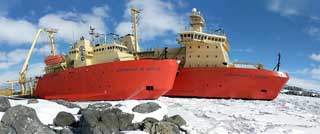 This is something that hasn't happened since July of 2000 (2000 photo by Zenobia Evans in the USAP Photo Library). Normally the Gould provides support to the station, while the much larger Palmer (which is too large to dock at the station's 1966-vintage pier) conducts wider ranging science cruises in the Southern Ocean. Here's a closer-in view of the two vessels; both of these photos are by Rachel Shackleford.
This is something that hasn't happened since July of 2000 (2000 photo by Zenobia Evans in the USAP Photo Library). Normally the Gould provides support to the station, while the much larger Palmer (which is too large to dock at the station's 1966-vintage pier) conducts wider ranging science cruises in the Southern Ocean. Here's a closer-in view of the two vessels; both of these photos are by Rachel Shackleford.
Venerable Skytrak forklift retired and shipped out.
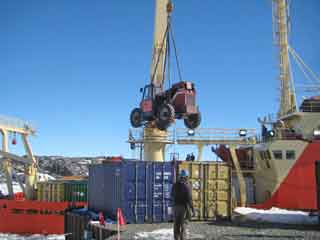
This brand-new Skytrak 6036 forklift was delivered to Palmer Station by the Polar Duke in March of 1990, to replace an obsolete military all-terrain forklift for which parts were getting hard to find. But that was almost 30 years ago, and during the 2019-20 summer that forklift was retired in its turn. The story...
Chuck Amsler completed his 1000th dive in Antarctica (13 January).
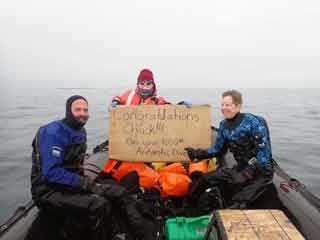
Charles Amsler, age 61, a biology professor at the University of Alabama Birmingham (UAB) is only the third USAP person (and the first USAP scientist) to reach this milestone. He made his first dive at Palmer Station in December 1985...and the rest have occurred over 23 field seasons, mostly at or around Palmer. The project this season involved studying the effects of ocean warming and acidification on algal-feeding crustaceans. This 4 February UAB news release describes Amsler's work and includes a photo of him at Palmer with his wife Maggie Amsler, who completed her 500th such dive at Palmer during the 2019 winter.
And on 11 June, NSF announced that the 2020-21 USAP season will be...er..."different." The season will be limited to "activities that will...avoid irreversible damage" (ie maintenance), statutorily required studies such as the CTBT monitoring conducted in Palmer's IMS building and the AMLR convention monitoring, and vessel cruise project that do not require station support.
The endless summer...ended on 16 June as the Laurence M. Gould headed north.
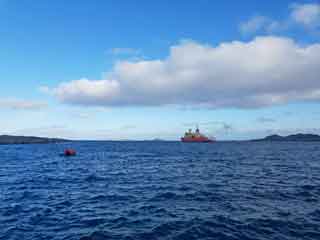
As of the end of May, the Palmer winterovers had not yet shown up, and some summer folks were still on station, all due to that nasty pandemic. Brief background...in January cruise ship visits were canceled. The LMG brought some of the summer Palmer people to PA on 21 March...they had to have a military/police escort to the airport. Next up, the NBP showed up on 24 March at the end of its Thwaites Glacier Collaboration project. The NBP eventually ended up at Eureka, CA in Humboldt Bay after a stop to discharge cargo at Port Hueneme. Uh...the Palmer 2020 winterovers finally headed south from PA on 3 June, and arrived at Palmer Station on the 10th. It headed north from Palmer Station on the 16th...four days before Midwinters Day Here is the rest of the now-finished story, including a look at the summerovers, many of whom were there for six months.
Winter 2020
Manager: Ken Keenan, population 16 (list and photos)
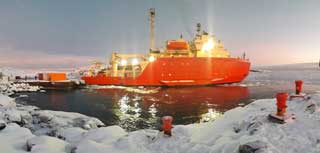 The Palmer webcam was stuttering when the Laurence M. Gould departed Palmer Station on 16 June, so here's a great photo from winterover Richard Osburn. This looked like a beautiful day for a sea cruise! The LMG detoured south to Vernadsky before heading to Punta Arenas (why? see below). And the vessel took a different scenic route this time...after heading up the east site of Tierra del Fuego, it entered the east end of the Straits of Magellan and headed west for Punta Arenas, where it arrived around 1200 local time (UTC-3) on 21 June.
The Palmer webcam was stuttering when the Laurence M. Gould departed Palmer Station on 16 June, so here's a great photo from winterover Richard Osburn. This looked like a beautiful day for a sea cruise! The LMG detoured south to Vernadsky before heading to Punta Arenas (why? see below). And the vessel took a different scenic route this time...after heading up the east site of Tierra del Fuego, it entered the east end of the Straits of Magellan and headed west for Punta Arenas, where it arrived around 1200 local time (UTC-3) on 21 June.

Why did the Laurence M. Gould call at Vernadsky overnight on 16-17 June? Back on 8 May local time, the Vernadsky cook Vasily Omelyanovich died from an apparent suicide, per this 112 UA Ukrainian news article. And there was a need to ship his body north. This had been his fifth deployment to Vernadsky. At left, an undated photo of Vasily Omelyanovich, presumably taken in Kiev, from that 112 UA news article.
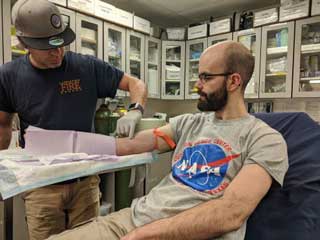 Due to the pandemic there was an absence of the usual grantees filling the aquarium building with marine life to study...so it turns out there was a NASA medical immune system study "Pilot assessment of stress and latent herpes virus reactivation" to help combat immune system dysregulation--a problem during long-duration space flight. How appropriate for a time of global pandemic! In this photo, Lance Roth (left) is drawing blood from Tim Lynch. The project also involved health surveys and spit and hair samples for evaluation of changes over the winter.
The principal investigator is Brian Crucian of the Johnson Space Center in Houston. He earlier conducted a similar study of Concordia winterovers. This photo is by Hannah James from the September 2020 station science report.
Due to the pandemic there was an absence of the usual grantees filling the aquarium building with marine life to study...so it turns out there was a NASA medical immune system study "Pilot assessment of stress and latent herpes virus reactivation" to help combat immune system dysregulation--a problem during long-duration space flight. How appropriate for a time of global pandemic! In this photo, Lance Roth (left) is drawing blood from Tim Lynch. The project also involved health surveys and spit and hair samples for evaluation of changes over the winter.
The principal investigator is Brian Crucian of the Johnson Space Center in Houston. He earlier conducted a similar study of Concordia winterovers. This photo is by Hannah James from the September 2020 station science report.
Summer 2020-21
Ulp...that pandemic continued...and with that...a lack of science projects and news.
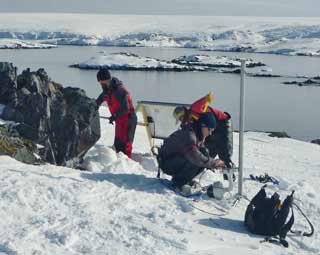
The researchers didn't show up, but the penguins did. So in mid-October 2020 it was time to set up the penguin webcam on Torgersen Island. Which is normally installed by the summer comms person, but since the summer crew hadn't arrived yet...winter person Mike Rice got to deal with it. Here's some of the equipment--2 135 watt solar panels, a remote controlled camera, an equipment/battery box, and other miscellaneous parts. Here's a look at the installation team and a view at some of the reasons for all this--a few hundred Adelie penguins. Photos from Mike Rice. Oh...the penguin webcam is not available during the austral winter, but you will find it here during the summer after the penguins show up to mate and lay eggs.
The pier construction for the 2021-22 summer was confirmed.

I've shared this preliminary 2018 design before here where I've included links to the preliminary drawings and other project information. Anyway...here is the 21 April 2021 Future USAP announcement as well as this 20 April NSF Dear Colleague Letter which indicated that there would be no on-station science personnel during the construction period...and that long term science projects would be maintained by ASC staff. The prime contractor Pacific Pile & Marine brought their materials and equipment on a barge from Seattle...and the construction efforts were also supported by extra trips by the Laurence M. Gould. Here is Pacific Pile & Marine's April 2021 post about the project. I should add that the final design was somewhat different than this preliminary one.
The Gould initially appeared with the winterovers on 8 May...

...but due to that COVID thing they didn't disembark until the 11th. The summer folks headed north on 24 May, arriving in Punta Arenas on the 29th. Here is Steve Allerding's photo of Palmer Station from the Laurence M. Gould the night before their departure.
Winter 2021
Manager: Ken Keenan, population 18 (list and photos)
Summer 2021-22
The new pier got built successfully...I have lots of photos I need to sort out.

For now, here's a late February 2022 photo showing the first piles and bents ready for the plank installation. The first set of planks were installed in one day! Photos from Zenobia Evans.
Winter 2022
Manager: Ken Keenan, population 19 (list and photos). The winterovers arrived on 22 May aboard the Laurence M. Gould after spending two weeks of COVID isolation in Puerto Natales.
What the new pier looked like in winter!
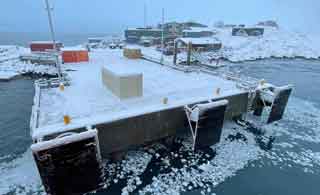
This is Ken Keenan's photo of the new pier, perhaps taken as the Nathaniel B. Palmer arrived in May. Very impressive...clean lines, engineered fenders instead of those large black floating ones...and a ladder, of course, as, unlike in the old days when I was there, Palmerites sometimes want to go for a swim. Here's another of Ken's photos showing the vessel "bumped up" at the pier.
Summer 2022-23
Replacement structures for NOAA's Livingston Island station built...in Denver!
The Laurence M. Gould will be going away...as well as other research vessels (Marissa Goerke photo).
 Its charter expires June 2024. There are fewer requests for vessel support...commercial charters might be cheaper and also allow science. My last trip to Palmer in March 1990 was on a commercial workboat as the Polar Duke, the research vessel at the time, was engaged at McMurdo. And those sponsons, installed on the vessel per this page, interfere with docking at the new pier. NSF also announced other research vessel retirements--the JOIDES Resolution and the Falkor which has been replaced with a new vessel with the same name, per this brief AAAS/Science article not linked separately but on this page. More recently, this 20 April AAAS/Science article describes complaints that the future vessel design does not include a helo pad.
Its charter expires June 2024. There are fewer requests for vessel support...commercial charters might be cheaper and also allow science. My last trip to Palmer in March 1990 was on a commercial workboat as the Polar Duke, the research vessel at the time, was engaged at McMurdo. And those sponsons, installed on the vessel per this page, interfere with docking at the new pier. NSF also announced other research vessel retirements--the JOIDES Resolution and the Falkor which has been replaced with a new vessel with the same name, per this brief AAAS/Science article not linked separately but on this page. More recently, this 20 April AAAS/Science article describes complaints that the future vessel design does not include a helo pad.
Coast Guard icebreaker Polar Star visits Palmer Station.
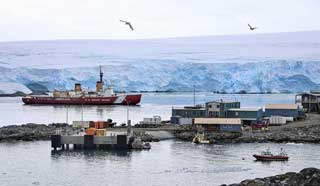 After ship offload at McMurdo was completed, Polar Star transited to Palmer Station, arriving in early March. This was its first visit to Palmer since November 1987, when ice and pier conditions required the Polar Duke to shuttle cargo from the icebreaker to the station. In the early years of Palmer Station, resupply was almost exclusively by Coast Guard icebreakers. Two relevant news articles--this 15 March Coast Guard News article which describes the Polar Star's Antarctic deployment, as well as a 10 March usap.gov article describing the Palmer visit. The photo at left, by Marissa Goerke, is from that article.
After ship offload at McMurdo was completed, Polar Star transited to Palmer Station, arriving in early March. This was its first visit to Palmer since November 1987, when ice and pier conditions required the Polar Duke to shuttle cargo from the icebreaker to the station. In the early years of Palmer Station, resupply was almost exclusively by Coast Guard icebreakers. Two relevant news articles--this 15 March Coast Guard News article which describes the Polar Star's Antarctic deployment, as well as a 10 March usap.gov article describing the Palmer visit. The photo at left, by Marissa Goerke, is from that article.Continuing the ship visits, MV Keith showed up in April (webcam photo).
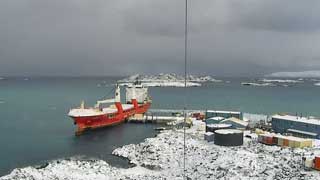 As a proof-of-concept for using commercial shipping, NSF arranged for this vessel to deliver cargo (and some winterovers) to Palmer...arriving around 12 March from PA and heading north on the 15th. The vessel is only 4 years old, flagged in Antigua-Barbuda, and features large cranes that are needed on vessels that deliver cargo to ports that don't have huge container cranes (think McMurdo). Here's an archived pdf data sheet from owner dship Carriers--this is one of two of their polar-rated vessels. As a test, they brought a tank container with 5000 gallons of fuel, they pressurized it with a Sullair compressor to about 70 psi to push the fuel up to one of the bulk tanks.
As a proof-of-concept for using commercial shipping, NSF arranged for this vessel to deliver cargo (and some winterovers) to Palmer...arriving around 12 March from PA and heading north on the 15th. The vessel is only 4 years old, flagged in Antigua-Barbuda, and features large cranes that are needed on vessels that deliver cargo to ports that don't have huge container cranes (think McMurdo). Here's an archived pdf data sheet from owner dship Carriers--this is one of two of their polar-rated vessels. As a test, they brought a tank container with 5000 gallons of fuel, they pressurized it with a Sullair compressor to about 70 psi to push the fuel up to one of the bulk tanks.
Winter 2023
Manager: Ken Keenan, population 20 (list and photos)
The end of winter!
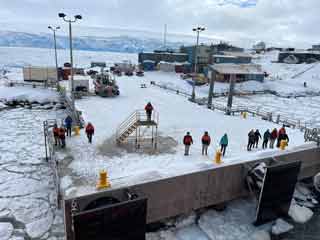
Here's Ken Keenan's photo of the pier, the summer folks, and the station, from the Laurence M. Gould as it heads north on 20 October 2023.
Summer 2023-24
New short paper published December 2023 discusses the retreat of the ice/glacier since 1963.

At left, a partial graphic from the paper (full size image: 1.2 MB). The open-access paper "Sixty years of glacial retreat behind Palmer Station, Antarctica" was published in December 2023 by Cambridge University Press and © The Authors...one of whom is friend Marissa Goerke who is the research associate at Palmer Station as I write this in March 2024. I was last on station in April 1990 and we never would have thought the ice cover would retreat like this...there's even an end to Hero Inlet!
The Laurence M. Gould makes its last call at Palmer Station (11 April).
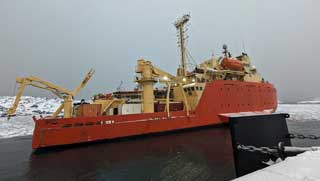
This was announced a while ago, but now the time has come as the charter from Edison-Chouest Offshore expires on 16 July 2024, per this 29 April 2024 NSF news article. I've previously covered this story above on this page with more links and info. This photo is from 2024 winterover Rachel Cook.
Winter 2024
Manager: Randal Rhodes, population 19...note that Ken Keenan, after wintering 11 times at Palmer, including 10 times as manager and 8 consecutive years from 2016, will be enjoying his first summer in either hemisphere in 8 years.